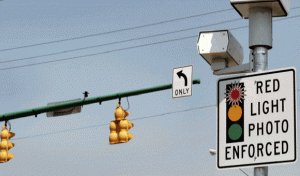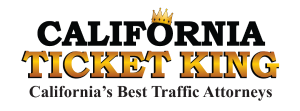Photo Red Light Tickets – CVC 21453

Red Light Violations and More!
Photo Red Light cameras catch other violations besides running red lights. The following is a list of violations that the police have been known to charge after reviewing photo red light evidence.
Red Light Violation Going Right or Straight – CVC 21453(a)
“A driver facing a steady circular red signal alone shall stop at a marked limit line, but if none, before entering the crosswalk on the near side of the intersection or, if none, then before entering the intersection, and shall remain stopped until an indication to proceed is shown, except as provided in subdivision (b).”
What is it?
This is a typical red light violation. This violation occurs when a vehicle crosses the limit line or enters the intersection going straight or on a right turn while the light is red.
What must the prosecution show?
- To prove this violation in court the officer must show
- The person driving was, in fact, the person named on the citation.
- The vehicle was proceeding right or straight at the intersection.
- At the time the vehicle crossed the limit line or entered the intersection if there is no limit line, the light was red (not yellow).
Failure to Yield At Red Light – CVC 21453(b)
“Except when a sign is in place prohibiting a turn, a driver, after stopping as required by subdivision (a), facing a steady circular red signal, may turn right, or turn left from a one-way street onto a one-way street. A driver making that turn shall yield the right-of-way to pedestrians lawfully within an adjacent crosswalk and to any vehicle that has approached or is approaching so closely as to constitute an immediate hazard to the driver, and shall continue to yield the right-of-way to that vehicle until the driver can proceed with reasonable safety.”
What is it?
This violation occurs when a vehicle takes an otherwise a lawful turn (right or left) against a red light, but fails to yield to oncoming traffic or pedestrians in a crosswalk.
What must the prosecution show?
To prove this violation in court the officer must show
- The person driving was, in fact, the person named on the citation.
- The vehicle was proceeding right on a red light or left on a red light (from one-way street to one-way street).
- At the time the vehicle made the turn it failed to yield to oncoming traffic or pedestrians lawfully in the crosswalk.
- Such movement of the vehicle caused an immediate hazard.
Red Light Violation Going Left – CVC 21453(c)
“Except when a sign is in place prohibiting a turn, a driver, after stopping as required by subdivision (a), facing a steady circular red signal, may turn right, or turn left from a one-way street onto a one-way street. A driver making that turn shall yield the right-of-way to pedestrians lawfully within an adjacent crosswalk and to any vehicle that has approached or is approaching so closely as to constitute an immediate hazard to the driver, and shall continue to yield the right-of-way to that vehicle until the driver can proceed with reasonable safety.”
What is it?
This is a typical red light violation for left turns. This violation occurs when a vehicle crosses the limit line or enters the intersection turning left while the light is red.
What must the prosecution show?
- To prove this violation in court the officer must show
- The person driving was, in fact, the person named on the citation.
- The vehicle was proceeding left at the intersection.
- At the time the vehicle crossed the limit line or entered the intersection if there is no limit line, the light was red (not yellow).
Failure to Stop at Railroad Crossing – CVC 22451(a)
“The driver of any vehicle or pedestrian approaching a railroad or rail transit grade crossing shall stop not less than 15 feet from the nearest rail and shall not proceed until he or she can do so safely, whenever the following conditions exist:
“(1) A clearly visible electric or mechanical signal device or a flagman gives warning of the approach or passage of a train or car.”
“(2) An approaching train or car is plainly visible or is emitting an audible signal and, by reason of its speed or nearness, is an immediate hazard.”
What is it?
This violation occurs when a driver fails to stop at a clearly marked railroad crossing.
What must the prosecution show?
To prove this violation in court the officer must show
- A driver or pedestrian was approaching a railroad crossing.
- At such time a train was approaching the crossing.
- The crossing had a clearly visible electronic or mechanical device or flagman giving a warning of the approaching train.
- The train approaching is clearly visible or emitting an audible sound signaling that it is crossing.
- The train is an immediate hazard because it is going fast or is close to the crossing.
Proceeding Past Railroad Crossing While Gate Closed – CVC 22451(b)
“No driver or pedestrian shall proceed through, around, or under any railroad or rail transit crossing gate while the gate is closed.”
What is it?
This violation occurs when a driver proceeds past a railroad crossing while the gate is down.
What the prosecution must show?
In order to prove this violation in court, the prosecution must show
- A driver is approaching or stopped at a railroad crossing.
- Such railroad crossing has a gate.
- That gate is closed.
- The driver proceeds over or past the railroad crossing while the gate is closed.
Disobedience To Official Traffic Control Device Not At Intersection – CVC 21455
“When an official traffic control signal is erected and maintained at a place other than an intersection, the provisions of this article shall be applicable except those provisions which by their nature can have no application. Any stop required shall be made at a sign or crosswalk or limit line indicating where the stop shall be made, but in the absence of any such sign or marking the stop shall be made at the signal.”
What is it?
This violation occurs when a driver disobeys an official traffic control device that is not placed at or within an intersection.
What must the prosecution show?
In order to prove this violation in court, the prosecution must show
- An official traffic control device was placed somewhere besides an intersection.
- Such traffic control device requires a stop
- A driver failed to stop at the sign, crosswalk, or limit line.
Disobedience to Official Traffic Control Device At Intersection – CVC 22101(d)
“When official traffic control devices are placed as required in subdivisions (b) or (c), it shall be unlawful for any driver of a vehicle to disobey the directions of such official traffic control devices.”
What is it?
This violation occurs when a driver disobeys any official traffic control device placed at or within an intersection.
What must the prosecution show?
In order to prove this violation in court, the prosecution must show
- An official control device was placed at or within an intersection.
- The driver disobeyed that device.
Learn More…
If you are charged with violating the California Vehicle Code, hire California’s best ticket law firm. We will substantially increase the odds of getting your ticket dismissed, fines reduced, or DMV points avoided. To learn more about our procedures and how we can fight your traffic ticket, call the California Ticket King, PC at 619-708-2073 or email our attorneys at info@caticketking.com.
We Go To Court For You!
Attorney Advantage
Hiring an attorney to defend your traffic ticket may mean the difference between a conviction and a dismissal. With high fines, DMV points and your license at stake, you need an experienced traffic law firm to handle it. Our traffic attorneys are the best in the business because:
Knowledgeable
We know the law and procedure that govern traffic law and traffic courts. We use the knowledge we've gained to get an advantage in court. Knowing the right legal maneuvers may mean the difference between a conviction and a dismissal.
We go to court for you
Under Penal Code 977 we can make all your court appearances without you having to be present. In most cases, you will never have to go to court. We appear on your behalf and represent you to the fullest extent of the law.
Cost effective
Hiring an attorney doesn't have to be expensive. Our fees are reasonable because we have designed our business to be efficient. Many clients actually save money because they have hired our law firm.
